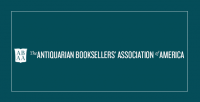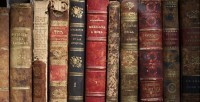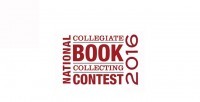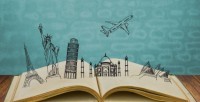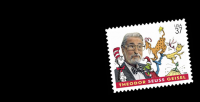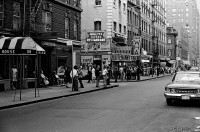The ABAA's Woodburn Fund provides financial support for scholarly research and education relevant to the antiquarian book trade. This includes annual scholarships to Rare Book School, California Rare Book School, and the Colorado Antiquarian Book Seminar. Ezra Tishman of Aardvark Books/Ezra the Bookfinder was the recipient of a Woodburn Fund scholarship to Rare Book School this year and had the following to say about his experience. I wanted to take moment to officially thank the ABAA for the scholarship assistance I received to attend a Rare Book School course in Bloomington, Indiana. The assistance allowed me to take the time off from work, and I spent an amazing week at Indiana University's Lilly Library, learning from the legendary "Master of Bibliographical Resources", Joel Silver. His encyclopedic knowledge of available references -- and his folksy delivery of just a slice of his vast body of knowledge — rather blew me away. In the first two days of the course — despite twenty-five years fulltime in the trade, I truly wondered about what I really knew, and how I could have worked so long without the benefit of some of these resources. I've no doubt at all that what I gained from attendance at Joel's course will prove indispensable, in both my capacities as bookseller and appraiser. Again huge gratitude to our organization for its commitment to help members grow and thrive in the trade. Scholarships to Rare Books School and California Rare Book School are awarded ann... [more Woodburn Fund Scholarship Recipient on Rare Book School]
Et Cetera
In memory of long-time member George Robert Kane (Oct. 6, 1913–Nov. 28, 2009), the Northern California Chapter of the Antiquarian Booksellers' Association of America announces the availability of an Educational Scholarship. In the interest of promoting professionalism and education relevant to the antiquarian book trade, persons currently working in or actively pursuing a career in the book trade are especially encouraged to apply. The Scholarship will pay tuition cost (to $1,500) for participation in a course of study offered by the following programs in the Summer/Fall of 2019: California Rare Book School (Los Angeles); Colorado Antiquarian Book Seminar (Colorado Springs); Rare Book School (Charlottesville, Virginia, as well as several other locations). To apply for the NCC/ABAA Educational Scholarship, please provide the following: 1) A completed copy of the application form. 2) A personal statement or essay (no longer than two pages) in which you describe your past or current experience in the world of rare books, your goals for the future, and what you hope to gain from the studies afforded by this scholarship. 3) Letter of support written by a professional bookseller or rare book librarian. Please email the NCC Secretary, Alexander Akin, to obtain an application: akin.alex@gmail.com. All applications must be received by 5:00 p.m., Friday, May 3, 2019. The NCC/ABAA will notify scholarship applicants of its award decision via email by May 10, 2019. Each application must... [more 2019 George Robert Kane Memorial Scholarship]
I'm thrilled to announce the winners of this year's National Collegiate Book Collecting Contest: 1st Place: Luke Kelly. Harvard Unversity. “A Collection of Eugene Walter, King of the Monkeys” 2nd Place: Megan Jones. University of Kansas. "The Life and Times of Sacco and Vanzetti" 3rd Place: Micaela Beigel. Goucher College. “Once We Were Dreamers: A Collection of Jewish Resistance During the Holocaust” Essay award: Samantha Flitter. Princeton University. “The Sand and the Sea: An Age of Sail Library in Rural New Mexico” The judges were impressed with the stories and thought that went into assembling these collections and wish to thank all who participated. The Awards Ceremony will take place at the Library of Congress on October 14th at 5:30pm. Our featured speaker is Toni Tipton-Martin. The event is free and open to public. Thanks to all who entered. [more 2016 National Collegiate Book Collecting Contest Winners Announced]
Personal confession: normally I am a proponent of all types of blogging. Though I believe the (not-so-old) adage “Don't believe everything you read on the internet,” I also find the internet to be a most useful place for information. Some of it genuine… some of it not quite so genuine… some of it kind, some of it negative. In any case, the internet is a fount of information. And I do use it – boy, do I use it! However, that being said, there is one thing that I cannot make up my mind on how I feel about it. The internet is partially responsible (in my own humble opinion) for making one particular genre of published book not quite as popular anymore. Travel Writing. Nowadays, just about anyone can and does post just about anything they want online. They went on a hike with their girlfriend and found a killer “secret” camping spot? Let's tell the entire online world! (Not so “secret” anymore – so much for skinny dipping!) Did you travel to Versailles with your parents and take pictures of every single item of gold you saw? Post them to Facebook! Gone are the old days where someone went on adventures that others might never experience and went home to write colorful and descriptive tales about their travels. Travel writing had to be good enough, exciting enough and gripping enough to spend money to publish it – it had to appeal to the masses. Now don't get me wrong – I love to travel and always want to write about my “adventures” – but I would rathe... [more Has Blogging Killed Travel Writing?]
If someone says “Children's Books” to you, what is the first thing that comes to your mind? Picture books? Perhaps here is the better question… what author first comes to mind? I would venture to bet that at least 90% of you come up with the same name. However, did you know that the name you come up with is not his true name? (Probably most of you do, since you are members of the book world or bibliophiles and would know something like that… but humor me!) Theodor Seuss Geisel was born on March 2nd, 1904 to a German family in Springfield, Massachusetts. His father ran a family-owned brewery in Massachusetts (well, until the Prohibition did away with that). Geisel went to school in Massachusetts until he went to Dartmouth College in New Hampshire, graduating in 1925. During his time at Dartmouth, Geisel first showed skill and interest in humorous literature as rose to the role of editor-in-chief of the literary magazine the Dartmouth Jack-O-Lantern before graduating. Unfortunately, one college incident threatened to end his early literary career – when Geisel was caught drinking gin (the Prohibition was in effect) in his dorm room with some of his friends. In punishment for this crime, Geisel was forced to resign from his position at the magazine. In order to continue publishing his work at the Jack-O-Lantern, Geisel began writing under the pen name “Seuss”, his middle name. The beginning of Dr. Seuss was underway. Once graduating from Dartmouth, Geisel began his... [more Dr. Seuss: Rare Books & Ephemera]
When visiting New York for the annual Antiquarian Book Fair, many attendees spend the entirety of their time within a fairly narrow geographic radius of the fair itself. That's understandable -- the Upper East Side has much to recommend it, and for convenience to the fair, it can't be beat. But New York City is a rich tapestry, and bookish pleasures abound throughout. Why not let the fair serve as an opportunity to grab a cab or hail an Uber and explore further afield? For sheer literary density, New York's crown jewel has to be the downtown neighborhood of Greenwich (that's "grennitch") Village. Universally referred to by natives simply as "The Village, this historic district is bounded by 14th Street on the north, Houston Street on the south, 3rd Avenue in the east, and the Hudson River to the west. Originally a bucolic out-of-town escape destination for disease-beset 18th- and 19th-century New Yorkers, the area retained its post-colonial flavor even as the city, marching ever northward, expanded around it. The Village's smaller scale, tree-lined streets, pocket parks, off-the-grid layout, and Bohemian sensibility has long attracted literary types, among them W. H. Auden, Willa Cather, Kahlil Gibran, Allen Ginsberg, Henry James, Jack Kerouac, Emma Lazarus, Edna St. Vincent Millay, Eugene O'Neill, Edgar Allen Poe, Dylan Thomas, Mark Twain, Thomas Wolfe, and many more. The area was the cradle of the "golden age" of New York literary society (dates vary, but broadly from the 1... [more Literary Greenwich Village]
Since 1975 the William Reese Company has served a large international clientele of collectors and private and public institutions in the acquisition of rare books and manuscripts and in collection development. With a catalogue inventory of over forty thousand items and a general inventory of over sixty-five thousand items, we are among the leading specialists in the fields of Americana and world travel, and maintain a large and eclectic inventory of literary first editions and antiquarian books of the 18th through 21st centuries. Our offices are located in downtown New Haven, Connecticut and are open by appointment only. The William Reese Company is seeking to add a new team member to its Americana Department. This person needs to be detail oriented, personable and outgoing, and willing and able to lift reasonably large boxes of books. A foundational knowledge of American history is a must, as is a basic grounding in bibliographical knowledge. Previous experience in antiquarian book selling or library work is preferred but not essential. Excellent communication skills, both oral and written, are necessary, as is proficiency in the use of databases. The job description includes a range of the many tasks required in running a large rare book business, but primary duties are cataloguing and researching new inventory; working with customers and selling books in person, on the phone, and by catalogue or internet listing; maintaining inventory control; and possible travel to attend... [more Job Posting: William Reese Co. Seeks Rare Book Cataloguer in Americana Department]
Please join us on October 21st at 3pm ET to honor this year's prizewinners of the National Collegiate Book Collecting Contest's Susan Tane Prize for Student Book Collectors by Zoom. In addition to the awards, the Library of Congress' Chief of Rare Books and Special Collections Division, Mark Dimunation, will interview each winner. To attend, you must register for the Zoom meeting at this link. First Prize Daria Rose Evdokimova (Harvard University) "Ardis Publishers and the Immigrant Identity" Second Prize Francesca Mancino (Case Western Reserve University) “Reassessing Modernism: Women Writers and Publishers of the Lost Generation” Third Prize Austin Benson (University of Virginia) “The Little Office of Our Lady, 1599-1966: Online Book Collecting During the COVID-19 Pandemic.” Essay Prize Elizabeth Propst (Harvard University) “How Much Am I Bid for the Moon?: Collecting Poetry on the Cheap” With thanks to our colleagues and judges from the Fellowship of American Bibliophilic Societies (FABS), the Grolier Club, and the Center for the Book and the Rare Books and Special Collections Division (the Library of Congress) for making the contest happen once again, and to Susan Tane for funding the prizes. We look forward to seeing you there. NCBCC Award Ceremony Registration [more National Collegiate Book Collecting Contest Awards on October 21]
Seeking Full Time Administrative Assistant for Online Rare Map Gallery ** No Application without a Cover Letter will be considered ** Geographicus is offering an exciting position in the antique business. We are one of the world's most active dealers in rare and antique maps. Geographicus has been in business since 2001 and is today one of the top dealers in authentic antique maps. We also exhibit at rare map and book fairs in Miami, New York, Boston, San Francisco, Chicago, London, Paris, and Korea. The business currently operates out of the ground floor of my Brooklyn townhouse. We do not have a physical gallery/storefront, as most of our business is online or through shows. We currently have 4 employees, including the owner. All three are focused on cataloging/sales. The position we are hiring for is not sales/cataloging, rather it combines support, management, and logistics. Duties 1. Pack and ship all outgoing parcels. Deal with outgoing customs. Track shipped parcels to ensure delivery. Liaise with clients, resolve shipping issues with FedEx / DHL / USPS support. 2. Track, receive, unpack all incoming parcels. Deal with incoming customs documentation. Build positive relationships with carriers. 3. Encapsulate new inventory in mylar, put into storage, and note appropriate locations after the cataloging process. 4. Collect and scan invoices, making sure all are paid in a timely fashion. 5. Liaise with auction houses around the world, deal with payment and arrange shipment... [more Rare Map Gallery Seeks Administrative Assistant]
BSA NEW SCHOLARS PROGRAM (DEADLINE SEPTEMBER 3) The Bibliographical Society of America's New Scholars Program promotes the work of scholars new to bibliography, broadly defined to include the creation, production, publication, distribution, reception, transmission, and subsequent history of all textual artifacts. This includes manuscript, print, and digital media, from clay and stone to laptops and iPads. Thanks to a recent donation to BSA in honor of Jacob Blanck (1906-1974), the New Scholars Program now provides named support for bibliographical and book historical scholarship focusing on printed works of writers of the United States and their publishers, in addition to the program's Malkin and Pantzer awards. The New Scholars award is $1,000, with a $500 travel stipend. Three awards are made each year as part of a two-pronged program: 1. New Scholars present fifteen-minute talks on their current, unpublished bibliographical research during a program preceding the Society's Annual Meeting, held each January. 2. Expanded versions of New Scholars' papers are submitted to the editor of The Papers of the Bibliographical Society of America (PBSA) for publication, subject to peer review. The committee strongly encourages applications from those who have not previously published, lectured, or taught on bibliographical subjects. Bibliographical scholarship pursuing new methods and new approaches, including applications from candidates applying bibliographical theory and principles ... [more Bibliographical Society of America’s New Scholars Program]


